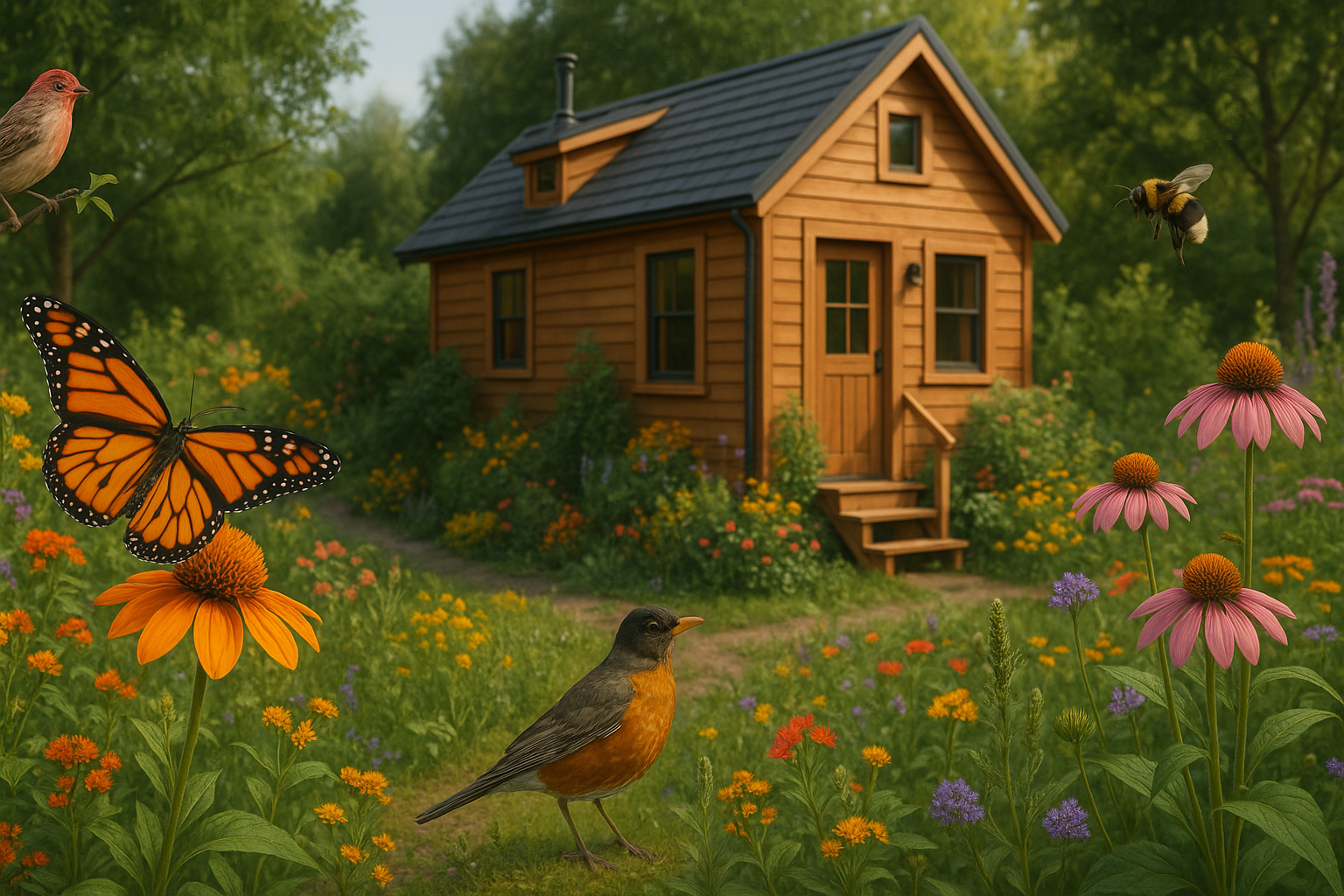
Wildlife-Friendly Landscaping for Tiny Homes: A Practical Guide to Supporting Birds, Pollinators, and Biodiversity
Estimated reading time: 8 minutes
Key Takeaways
- Support Local Wildlife: Implementing wildlife-friendly landscaping with native plants helps attract birds, pollinators, and beneficial insects.
- Sustainable Practices: Techniques such as rain gardens, permeable pathways, and pesticide-free gardening contribute to a healthier ecosystem.
- Space-Smart Design: Even tiny homes and ADUs can boast multifunctional outdoor spaces by combining vertical planting, container gardens, and dual-purpose landscaping features.
- Practical Tips: Step-by-step guidelines including soil preparation, plant selection, and maintenance ensure that every square metre counts.
Table of contents
- Introduction: Wildlife-Friendly Landscaping for Tiny Homes
- Understanding Wildlife-Friendly Landscaping: Vital Concepts for Tiny Homes
- Designing Outdoor Spaces to Support Native Birds
- Incorporating Pollinators into Your Landscape
- Balancing Beauty and Functionality in Small Spaces
- Practical Landscaping Tips Specific to Tiny Homes and ADUs
- Conclusion
- Frequently Asked Questions
Wildlife-friendly landscaping is more than just a trend—it’s a vital practice for anyone who owns a tiny home or accessory dwelling unit (ADU) in Canada. As cities expand and natural habitats shrink, homeowners have a unique opportunity to make a real impact right outside their door.
With thoughtful landscaping, even the smallest outdoor spaces can become havens for native birds, pollinators, and other wildlife. In this post, you’ll learn how to design outdoor spaces that enhance the beauty of your tiny home while providing a supportive habitat through strategic plant choices and space-smart features.
You will learn how to:
- Welcome native birds with smart plant selection and simple amenities.
- Attract pollinators by planting native flowers and avoiding harmful chemicals.
- Maximize small-space landscaping with multifunctional, attractive designs.
- Apply practical tips and step-by-step guidance specific to tiny homes and ADUs.
For more on tiny home living, its lifestyle rewards, and innovative design, check out this tiny home living guide.
Understanding Wildlife-Friendly Landscaping: Vital Concepts for Tiny Homes
Wildlife-friendly landscaping means designing your outdoor space—no matter how big or small—to support biodiversity. This approach is especially important for homeowners of tiny homes and ADUs, where every square metre can make a difference for local wildlife.
What is Wildlife-Friendly Landscaping?
- Intentional plant selection: Select native plants that are naturally suited to your local soil and climate. These species, like wild columbine or highbush cranberry in Ontario, thrive with less maintenance and attract local birds and insects.
- Biodiversity boost: Incorporate a variety of species and create layers—from low ground cover to tall plants—to provide food, shelter, and safe nesting spots.
- Sustainable practices: Reduce water use, avoid pesticides, and enrich soil with natural compost or mulching.
Why Native Plants Matter
- Familiar food: Many native birds and pollinators rely on local trees, shrubs, and flowers.
- Better adaptation: Native species are more drought-resistant and disease-tolerant.
- Healthy support: They promote a resilient ecosystem by attracting beneficial insects and supporting balanced habitats.
Benefits of Wildlife-Friendly Landscaping
- Supports declining populations of birds and pollinators.
- Improves water retention and soil health, reducing flooding and erosion.
- Lowers maintenance and gardening costs.
- Deepens your connection with nature.
For practical guidelines and deeper insights, check out this resource, another guide, and the gardening guide. Learn more about smart landscaping for ADUs here.
Designing Outdoor Spaces to Support Native Birds
Birds and Native Landscaping Around Tiny Homes
Birds add beauty and life to your garden. They help control pests and occasionally pollinate plants. Even in the small gardens characteristic of ADUs and tiny homes, you can design spaces that benefit and attract native birds.
How to Attract Native Birds: Key Strategies
- Berry-producing shrubs: Plants like serviceberry and elderberry offer fruits that feed birds during migration and winter.
- Seed-bearing grasses: Native grasses such as little bluestem and switchgrass provide seeds and shelter all year round.
- Shelter elements: Dense shrubs, evergreens, and hedgerows create safe nesting and hiding spots. Where larger trees are scarce, a sturdy nest box in a shaded area can be a perfect alternative.
- Clean water sources: A shallow bird bath or small fountain gives birds a safe place to drink and bathe, even attracting species that rarely visit feeders.
- Natural groupings: Plant in clusters or layered thickets to encourage foraging and provide cover.
- Maximizing small spaces: Use vertical planting, like climbing honeysuckle or clematis, or create multi-functional structures such as benches with shrubby borders.
Pro-Tips for Success:
- Mix plants that offer food, shelter, and nesting spots.
- Place bird-friendly zones away from windows to minimize collisions.
- Regularly clean bird baths and feeders to prevent disease spread.
For more detailed guidance and plant suggestions, check out this resource and the gardening guide.
Incorporating Pollinators into Your Landscape
Pollinators in Landscaping: Supporting Bees, Butterflies, and More
Pollinators like bees, butterflies, and hoverflies are true garden heroes. They are essential for pollinating many fruits and vegetables while keeping ecosystems balanced. However, native pollinators face threats from habitat loss and pesticide use, especially near urban areas and tiny home subdivisions.
How to Support Pollinators in Your Tiny Home Landscape
- Plant native, nectar-rich flowers: Plants such as milkweed (vital for monarchs), wild bergamot, asters, and goldenrod are local favourites. Aromatic herbs like mint and thyme also serve as magnets for beneficial insects.
- Ensure bloom succession: Choose a variety of plants that blossom at different times from spring through late fall to maintain a steady supply of nectar and pollen.
- Embrace variety: Opt for single-flowered types that offer easier access to pollen and nectar rather than double-flowered hybrids.
- Pesticide-free gardening: Rely on organic methods and integrated pest management to keep pollinator populations healthy.
- Create pollinator pathways: Even narrow planting strips along fences or walkways provide “stepping stones” for insects, linking fragmented habitats.
Quick Plant List for a Pollinator Garden:
- Common milkweed (Asclepias syriaca)
- Wild bergamot (Monarda fistulosa)
- Black-eyed Susan (Rudbeckia hirta)
- Purple coneflower (Echinacea purpurea)
- Aromatic herbs: mint, thyme, oregano
Tips for Maximizing Impact:
- Leave small patches of bare ground or sand for native bee nesting.
- Provide a shallow water dish with pebbles for insects to safely land on.
- Add logs or stones for shelter and breeding.
For comprehensive planting guides and pesticide-free alternatives, visit this guide and the gardening guide.
Balancing Beauty and Functionality in Small Spaces
Tiny Homes and Landscaping: Merging Aesthetics with Ecology
Landscaping for wildlife doesn’t mean you have to sacrifice style or usability. When space is at a premium around tiny homes and ADUs, combining multifunctional design with natural beauty is key.
Strategies to Enhance Both Form and Function:
- Vertical gardens and trellises: Use fences, arbours, or walls to support native vines like Virginia creeper or climbing honeysuckle, adding greenery while maximizing space.
- Container planting: Native perennials and shrubs thrive in pots and planters, giving you the flexibility to reconfigure your layout seasonally.
- Double-duty design: Consider benches with built-in planters, raised beds with seating, or rainwater collectors that feed a small pond to boost habitat value.
- Framing your space: Use clusters of native plants to outline patios or decks, creating inviting spaces that also serve as habitats.
- Low-maintenance choices: Choose drought-tolerant and pest-resistant species to reduce upkeep while maintaining beauty.
For more ideas on designing attractive and functional wildlife-friendly yards, refer to this gardening guide and discover additional tips for ADUs here.
Practical Landscaping Tips Specific to Tiny Homes and ADUs
Step-by-Step Landscaping for Tiny Homes: Birds, Pollinators, and Beyond
1. Test and Prepare Your Soil
- Conduct a simple soil test using kits from local garden centres.
- Amend with compost or leaf mould to boost native plant growth.
- Avoid peat-based amendments to protect sensitive wetlands.
2. Choose the Right Native Plants
- Research species well-suited to your local ecozone.
- Select shade-tolerant options like wild ginger or trilliums, and sun-loving species like goldenrods or wild strawberries.
3. Incorporate Special Features
- Rain gardens: Collect runoff from roofs and patios with water-tolerant natives such as cardinal flower or blue flag iris.
- Permeable pathways: Use mulch, gravel, or spaced paving stones to reduce runoff and manage water effectively.
- Built-in planter edges: Create seamless transitions between sitting areas and planting beds with raised beds or wall planters.
4. Go Vertical and Modular
- Utilize porch steps, shelves, or privacy screens to hang small planters or nest boxes, optimizing space by growing upward instead of outward.
5. Add Small, Impactful Elements
- A tabletop water dish for butterflies.
- A shallow, heated bird bath suitable for all seasons.
- Sun-catching stones or small sand patches for bee nesting.
6. Maintain Naturally
- Mulch beds to suppress weeds.
- Remove invasive or overcrowded plants annually.
- Avoid harsh chemicals by opting for manual weeding and organic methods.
Even modest enhancements, such as a single raised bed or a mini pollinator garden, can significantly impact local wildlife habitats. For more in-depth guides, visit this gardening guide.
Conclusion
Wildlife-friendly landscaping is a powerful tool for tiny home and ADU owners. By integrating native plantings, water features, and pollinator pathways, you can create vibrant outdoor spaces that benefit both you and the local ecosystem.
Remember:
- Every flower and shrub contributes to supporting birds, bees, butterflies, and more.
- Sustainable yards require fewer resources and offer a deeper connection to nature.
- Even small changes—like adding a native shrub or a pollinator planter—can transform your environment into a crucial part of Canada’s conservation mosaic.
Ready to begin? Take the first step today by planting something local, swapping out a section of lawn, or placing a bird bath near your deck. Your actions will encourage wildlife and inspire your community.
For more info and detailed Canadian guidance, explore this resource, this guide, and the gardening guide.
Frequently Asked Questions
Q1: How do I choose the right native plants for my tiny home garden?
A1: Research the native plant species suited for your local climate and soil. Local garden centres, online resources, and regional guides can offer recommendations. Remember to consider both aesthetic appeal and functionality.
Q2: What are some low-maintenance features I can incorporate in a small space?
A2: Consider vertical gardens, container planting, and multi-purpose elements like benches with integrated planters. These options maximize space and require less upkeep while enhancing habitat value.
Q3: How can I ensure my garden remains sustainable and wildlife-friendly?
A3: Use sustainable practices such as organic mulching, rainwater harvesting, and avoiding synthetic pesticides. Creating continuous bloom succession and providing water features also help maintain a supportive ecosystem.
Q4: Can small spaces really make a significant impact on local biodiversity?
A4: Yes! Even modest additions like a native shrub or a mini pollinator garden can enhance local biodiversity. Every small space contributes to a larger network of wildlife-friendly habitats.

Leave a Reply